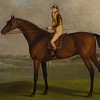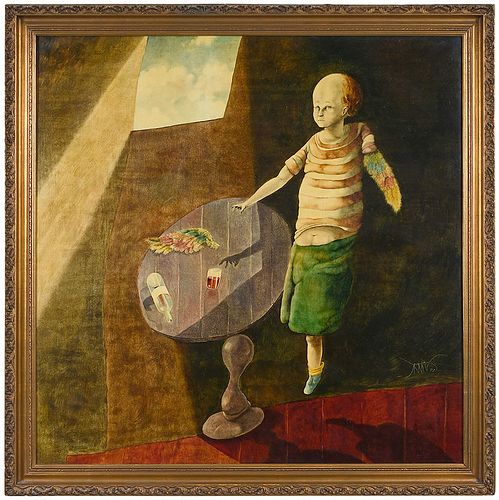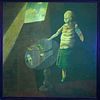(Salvadoran, 1933-1987)Icaro (Icarus), 1977, signed lower right and dated, oil on panel, 46-1/4 x 46-1/8 in.; modern gilt wood frame, 52-1/2 x 52-1/8 in.Exhibited: XIV Bienal Internacional,˜S?o˜Paolo, Brasil,˜Exposici›n Antol›gica˜(Restropectiva) de Benjamin˜Ca?as, 1977, No.32 (labels verso)Biography from the Museum of the Americas, OAC:"Benjamn Ca?as was born in Honduras and grew up in El Salvador, where he earned a degree in architecture from the Universidad Aut›noma. Throughout the 1950s and 1960s he earned a living as an architect, working for the city?s Department of Public Works and a variety of local firms. During the years 1957-1969 he studied at the Escuela de Bellas Artes de El Salvador with teachers Enrique Salaverria, C?sar Serme?o, and Benjamn Saul. Ca?as?s first solo exhibition took place in the art gallery of the Intercontinental Hotel in San Salvador in 1964. His paintings from this period consisted of lyrical abstractions, where subtle fields of color intermingle with small gestural forms that evoke figures. In 1969 he became chair of the Department of Fine Arts at the Universidad Aut›noma and had his second solo show at the Galera Dideco in the city. By the end of the year he had relocated to Washington, D.C., where he worked as an architect for Watergate Improvement and Associates. At this time Ca?as met the curator Jos? G›mez Sicre, who invited him to exhibit at the OAS the following year; he showed twelve drawings and eight oils, including major works such as La creaci›n del tiempo and ?ngeles Mayas, and his work began to receive international attention. Between 1969 and 1972 his work entered his ?Mayan? period due of his use of mythology and compositional structures derived from the pre-Columbian culture. By 1973 Ca?as had discarded the Mayan-influenced work and moved on to a more precise, quasi-surreal exploration of the figure, within which the letters of Franz Kafka to his various love interests became a source of inspiration. Distorted figures, miniature animals, and stage-like settings filled his compositions, which evoked existential pursuits and sexual tensions. He lived and worked in Annandale, Virginia until his death on December 8, 1987. In 1989 the Museum of Modern Art of Latin America (OAS) organized a retrospective of his work."˜Provenance: Estate of James Benjamin Mayberry, Tryon, North CarolinaNote: Exhibited: XIV Bienal Internacional,˜S?o˜Paolo, Brasil,˜Exposici›n Antol›gica˜(Restropectiva) de Benjamin˜Ca?as, 1977, No.32 (labels verso)Biography from the Museum of the Americas, OAC:"Benjamn Ca?as was born in Honduras and grew up in El Salvador, where he earned a degree in architecture from the Universidad Aut›noma. Throughout the 1950s and 1960s he earned a living as an architect, working for the city?s Department of Public Works and a variety of local firms. During the years 1957-1969 he studied at the Escuela de Bellas Artes de El Salvador with teachers Enrique Salaverria, C?sar Serme?o, and Benjamn Saul. Ca?as?s first solo exhibition took place in the art gallery of the Intercontinental Hotel in San Salvador in 1964. His paintings from this period consisted of lyrical abstractions, where subtle fields of color intermingle with small gestural forms that evoke figures. In 1969 he became chair of the Department of Fine Arts at the Universidad Aut›noma and had his second solo show at the Galera Dideco in the city. By the end of the year he had relocated to Washington, D.C., where he worked as an architect for Watergate Improvement and Associates. At this time Ca?as met the curator Jos? G›mez Sicre, who invited him to exhibit at the OAS the following year; he showed twelve drawings and eight oils, including major works such as La creaci›n del tiempo and ?ngeles Mayas, and his work began to receive international attention. Between 1969 and 1972 his work entered his ?Mayan? period due of his use of mythology and compositional structures derived from the pre-Columbian culture. By 1973 Ca?as had discarded the Mayan-influenced work and moved on to a more precise, quasi-surreal exploration of the figure, within which the letters of Franz Kafka to his various love interests became a source of inspiration. Distorted figures, miniature animals, and stage-like settings filled his compositions, which evoked existential pursuits and sexual tensions. He lived and worked in Annandale, Virginia until his death on December 8, 1987. In 1989 the Museum of Modern Art of Latin America (OAS) organized a retrospective of his work."˜˜
Condition
good condition











